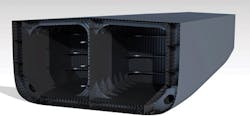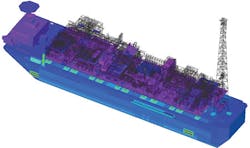Emerging digital technology will transform asset integrity management (AIM) systems, reducing the volume of inspection and the cost and downtime incurred during regular offshore maintenance, according to Matthieu de Tugny, Head of Offshore, Bureau Veritas. “We will shortly launch a new AIM system based on a digital twin 3D model of the offshore unit,” he explained. “We can already show that this will enable us and the unit operator to better focus inspection effort and reduce data entry.
“What is more exciting are the possibilities for digital transformation that will open up new ways of inspecting, maintaining, and certifying offshore units and all their equipment and process plants. Some we can see coming, such as placing sensors on all equipment and using the data to inform maintenance strategies, as is done already in the aerospace sector. But beyond that we can envisage other new services and cost-saving measures made possible by the new digital technology.”
De Tugny’s optimism is based on a recently formed partnership between Bureau Veritas and France’s Dassault Systè;mes, under which Bureau Veritas is integrating Dassault’s 3D EXPERIENCE platform and its Catia and Enovia 3D CAD tools with BV’s existing VeriSTAR calculation tools and AIM systems.
“Dassault Systè;mes is a world leader in 3D modeling and CAD solutions, with a massive presence in aerospace,” de Tugny said. “They already work with major shipyards such as Meyer Werft. We can help them into the offshore industry and they can help us with the speed, power, and interoperability of their 3D modeling tools.”
EPCI contractors, shipyards, and classification societies already routinely build finite element models of offshore plants and use them to assess initial design strength and suitability and to inform maintenance and life extension decisions. However, these models take time to build and have to be adapted for each purpose.
“The digital transformation comes from the speed at which the model can now be built, and the need to build only one complete model that can be used for everything and kept up to date easily,” de Tugny said. “Our new digital AIM system will be built on a complete digital twin model of the actual asset and a virtuous virtual loop that will keep it updated automatically so that it continuously reflects the actual condition of the asset and equipment.
“On the input side, the digital twin will interface automatically with connected surveyors and inspection and testing data, and in the future with live data from sensors on the equipment. On the output side, the digital twin will interface directly with our structural calculation tools and with risk-based inspection (RBI) planning tools that will enable continual refinement and focusing of inspection effort. An interface with the operator’s ERP such as SAP will also be made available.”
Bureau Veritas has already reported that is has dramatically cut structural computational and verification times in the shipping industry using the same technology. The reduction in the time needed to check the structure, seakeeping, and stability of new vessels and floating offshore units is being delivered through the use of a powerful 3D model that links directly to BV’s entire VeriSTAR suite of calculation tools.
A pilot project with Chinese design institute SDARI has been completed. Two new Aframax and Suezmax tanker projects from this designer were modeled using the new 3D platform. The models were then automatically transferred into BV’s structural calculation software VeriSTAR Hull. The process enabled the designer to check compliance with the CSR Rules in a very quick, powerful, and simple way.
Bureau Veritas Marine & Offshore Division will introduce a series of new apps and services this year that should also improve communication between clients and the classification society.






